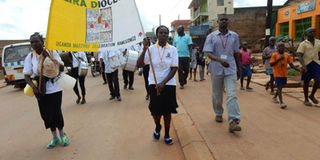What it means to make a pilgrimage to Namugongo

The writer (R) was part of the procession from Lira to Namugongo. Courtesy Photo
What you need to know:
What started as an assignment for Bill Oketch turned out to be a life-changing experience.
When I received a text message from my editor about Martyrs Day coverage, I pretended not to have seen or read it.
The message read: “Martyrs Day story. “Who is walking with the pilgrims?” I did not reply immediately because I had not prepared to walk the more than 384kms.
Secondly, I never wanted to be a pilgrim. Since I am based in Lira, I knew I had to rise to the occasion. I did not prepare for the journey so I simply informed close friends and family that I was going to execute a great task that would take me more than 10 days.
I bought a few things that could ease my journey such as vaseline, powder, bathing soap, toothpaste and toothbrush. Many friends cautioned against carrying heavy luggage.
Setting off
On May 23, I set off from Lira Town by bus and joined the pilgrims at Migeera where they were spending their fifth night.
I was amazed that the pilgrims remained upbeat yet five of their colleagues had been admitted to St Francis Health Centre, Migeera, with various ailments.
When the medical personnel at the facility said they had treated more than 30 pilgrims with swollen feet, I got worried.
First night
We spent that night at St Anthony Catholic Church, Migeera. Around 9pm the pilgrims lined up for the day’s meal. It was nothing fancy but a meal of boiled beans and posho. “Pe itok wunga adwong adwonga, ngee ni jo pwod odong adwong (Don’t serve a big portion of posho, you should know that many more people have not yet been served),” a female pilgrim warned a colleague. Then, it dawned on me that in my hurry to catch up with the pilgrims, I had forgotten to carry a plate or even a cup. What I had in my laptop bag were two pairs of trousers, two T-shirts, a shirt and sweater, which I had to turn into a “bed sheet”.
My first rest was on a plastic chair for about three hours before a good Samaritan gave me a small mat to lay.
The mat was small and as such, my lower torso remained on bare ground. That was the most uncomfortable night. The next day, I bought a mat. I did not know much but, thankfully, a 76-year-old pilgrim, Vincent Paul Ecetu, took me through the rules of the pilgrimage.
Rules and regulations
Men and women sleep separately regardless of whether they are husband and wife.
At the resting ground, phone calls are not allowed because it can cause “disorganisation”. If you broke this rule, a fine not exceeding Shs10,000 is slapped on you.”
There was also an issue of water scarcity. On some nights, we had to do without a shower.
While the pilgrims concentrated on their spiritual edification, I had to continue filing stories, keeping my editor updated about the progress of our journey.
I had two problems. My laptop saves power for only two hours. So, I had to work within that time since charging it was not always guaranteed.
Network availability was another hiccup. Many a time, I would pick a taxi and find where there is network coverage to file a story.
We had somehow become a family because we shared almost everything. I was eating one meal a day just like the pilgrims. I had small “facilitation” for general upkeep, which I sparingly used along the journey.
Memories
What stands out for me was an experience at Kakoge. The pilgrims branched off and worshipped at a giant crucifix. It was an emotional moment as many wept. One of the pilgrims said all the burdens they had, had been left at the Cross.
Sleeping was also another problem. We used to sleep for three hours. The hardest part was walking while carrying a heavy bag on more or less an empty stomach.
For the two days we were in Luweero, I had to use an internet café to file stories.
Besides the hiccups, nature also decided to reward us. As we were nearing Matugga, Wakiso District it rained yet we had nowhere to take shelter. We sought refuge at a nearby trading centre. We were all soaked.
Lessons learnt
When I accepted the assignment, I did not know what to expect. But here I was drenched by the rain yet I had nothing else to wear. I was exhausted. We were supposed to walk to Naguru but I could not take it anymore.
I was relieved when colleagues from NTV allowed me to put my luggage in their small car. We were joined by a band at Kawempe but I was too tired to enjoy the wonderful reception.
The band accompanied us to Naguru, where the pilgrims spent their 11th night. I slept in a guesthouse in Banda. I wanted to rest since the pilgrims were going to spend two nights at St Jude Catholic Parish before heading to Namugongo.
On Sunday, I joined the pilgrims for the final stretch to Namugongo. We set off at about midday and by 3pm we were at the Shrine. Like the pilgrims, I was excited that I had made it.
Before the journey, I thought the pilgrims were wasting their time by walking to Namugongo. But the generosity of people along the way made me realise there is more to this walking experience.
When I started the journey from Migeera, I did not believe I could walk up to Namugongo but by God’s grace I was able to make it.




